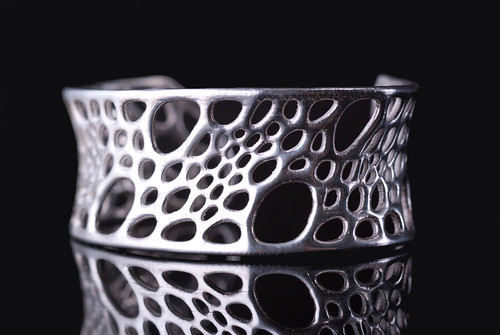
Ernst Haeckel, Kunstformen der Natur (1904), plate 31: Cyrtoidea
 Radiolarians (or radiolaria) occur as zooplankton throughout the oceans and their tiny skeletal remains can be used as diagnostic fossils to date submarine sediments. Biologist, naturalist, and scientific illustrator par excellence Ernst Heinrich Philipp August Haeckel (February 16, 1834 – August 9, 1919), and his beautiful and well-known Artforms in Nature can be credited for the fact that people who are not say, marine microbiologists or geostratigraphers or their colleagues, know and are inspired by the extraordinary forms of radiolarians. I am, of course, a fan of Haeckel, and he inspired my own prints (see right) of these amoeboid protozoa and their intricate mineral skeletons. I am far from alone in being inspired by radiolarians. I've found examples of their forms making their way into art, architecture, jewellery and even textiles. But first, you can learn everything you might want to know about radiolarians, and Haeckel's obsession with them, from this selection from Proteus a documentary about the life, work, and philosophy of Ernst Haeckel, by David LeBrun.
Radiolarians (or radiolaria) occur as zooplankton throughout the oceans and their tiny skeletal remains can be used as diagnostic fossils to date submarine sediments. Biologist, naturalist, and scientific illustrator par excellence Ernst Heinrich Philipp August Haeckel (February 16, 1834 – August 9, 1919), and his beautiful and well-known Artforms in Nature can be credited for the fact that people who are not say, marine microbiologists or geostratigraphers or their colleagues, know and are inspired by the extraordinary forms of radiolarians. I am, of course, a fan of Haeckel, and he inspired my own prints (see right) of these amoeboid protozoa and their intricate mineral skeletons. I am far from alone in being inspired by radiolarians. I've found examples of their forms making their way into art, architecture, jewellery and even textiles. But first, you can learn everything you might want to know about radiolarians, and Haeckel's obsession with them, from this selection from Proteus a documentary about the life, work, and philosophy of Ernst Haeckel, by David LeBrun.It should be noted that Haeckel wasn't the only 19th century naturalist to be enthralled. SEED Magazine has a photo gallery of the the collection of Howard Lynk, a hobbyist who researches the microcope slide-makers of the 1840s-1860s, with many radiolarians included, often arranged artistically, like mandalas.
" Radiolarians - In this slide, Amos Topping has arranged the minuscule shells of radiolarians—a kind of protozoa—into a radial pattern reminiscent of a mandala. Looking through a microscope, a mounter would maneuver the diatoms or shells using a boar bristle or a cat’s whisker, trying to keep them all in place long enough for mounting."
Artist Laura Gurton works with resin, and its unpredictable interactions with oil paint to produce her biomorphic images, including these, inspired by radiolarians.
Radiolarians (Marine Protozoa), Zygospyris,2010. Oil, Alkyd, Acrylic, Mica, Cut Board 36" x 24"
Spyridobotrys Trinacria, 2010. Oil, Alkyd, Cut Board on Panel 18" x 24"
A more fanciful image inspired by radiolarians is Queen Radiolaria by Morgainelefee on deviantart.
The wonderful and quixotic Hyperbolic Crochet Coral Reef ("a woolly celebration of the intersection of higher geometry and feminine handicraft, and a testimony to the disappearing wonders of the marine world") includes radiolarians!
Crochet radiolarian, made from mercerized cotton by Sarah Simons.

Quiltmaker and textile artist Jenny Bowker's portfolio of masterful quilts includes "Radiolarian Drift" (cotton homespun hand dyed in Procion dyes, raw silk as a background and wool batting).
The fascinating 3D forms of these creatures of course inspire sculptural and architectural works. Jessica Rosenkrantz of nervous system uses new technologies to reinterpret natural phenomena. The forms radiolarians are evident in a lot of the jewellery she has made (and their titles often indicate the species).

"Bamboo Cuff - sterling silver, lost wax casting from 3d-printed wax, Cell Cycle collection by Nervous System. Inspired by the microscopic glass skeletons of radiolarians."
Nigel Helyer created 'Radiolarians' a public artwork for the Lake MacQuarie City Gallery, installed in February 2011.
'Radiolarians' (2010) Finished construction: corten steel, marine grade stainless steel wire cable, stainless steel.
"The Radiolaria Project is a research and design project at the University of Kassel initiated by Christian Troche and Gregor Zimmermann. It aims to rethink architectural design and manufacturing techniques by exploring the filigree and beautiful skeletons of radiolarians, tiny marine organisms, with their striking hexagonal patterns. This concept is transfered to architectural scale and materialized it in a large scale interior installation by the intensive use of parametric modelling, scripting and CNC-fabrication techniques."
Images of the mesh and design from The Radiolaria Project. Be sure to check out the extensive website for the images and explanations of the evolution of the project (and the work of its participants).
Architect and designer Tomasz Starczewski and his studio produced DIATOM by analysing the siliceous skeletons of radiolarians, and extracting, the "logic of their structure and its application to creations of a new form." He created 3D computer models of a group of radiolarians (Lamprocyclas margatensis), modified the models and then used this to create objects with a 3D printer.
DIATOM by Tomasz Starczewski
Taking the 3D printed radiolarian to an extreme scale, Andrea Morgante of Shiro Studio in collaboration with D-Shape produced the Radiolaria pavilion. The 3 m by 3 m by 3 m structure, printed on the world's largest 3D printer is in fact a mere scale model a final 8-metre tall pavilion being built in Pontedera, Italy (more info at de zeen magazine and images via Shiro Studio). Shiro Studio compares the construction of this model, with its deposition of mineral and siliceous material, in a series of very thin layers to the formation of radiolarian mineral and siliceous skeletons.
You can find other posts tagged Ernst Haeckel here.
















No comments:
Post a Comment